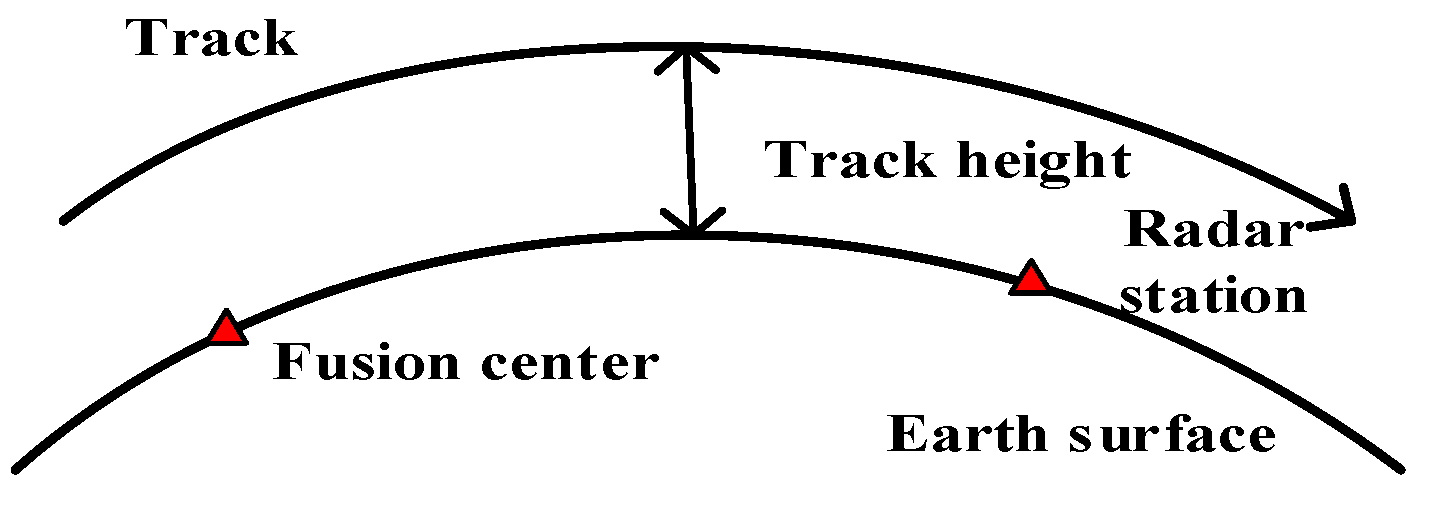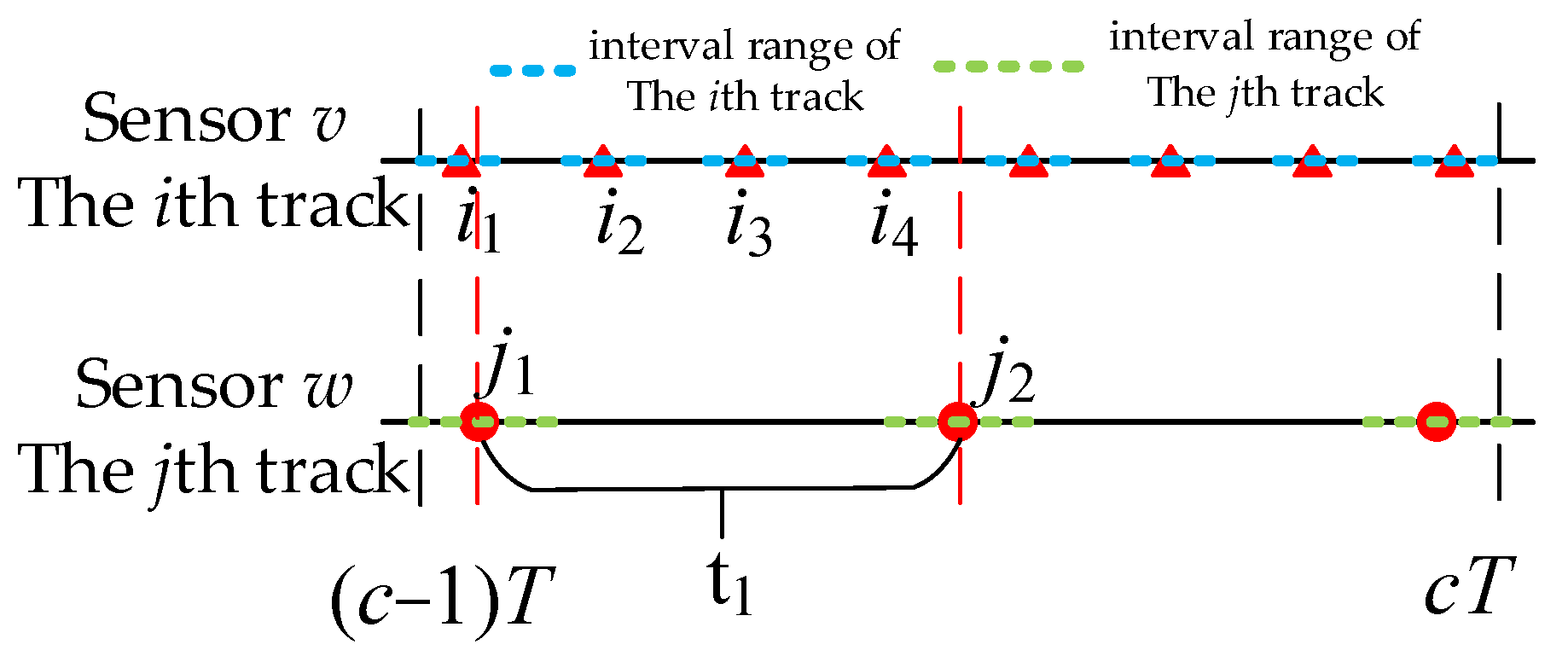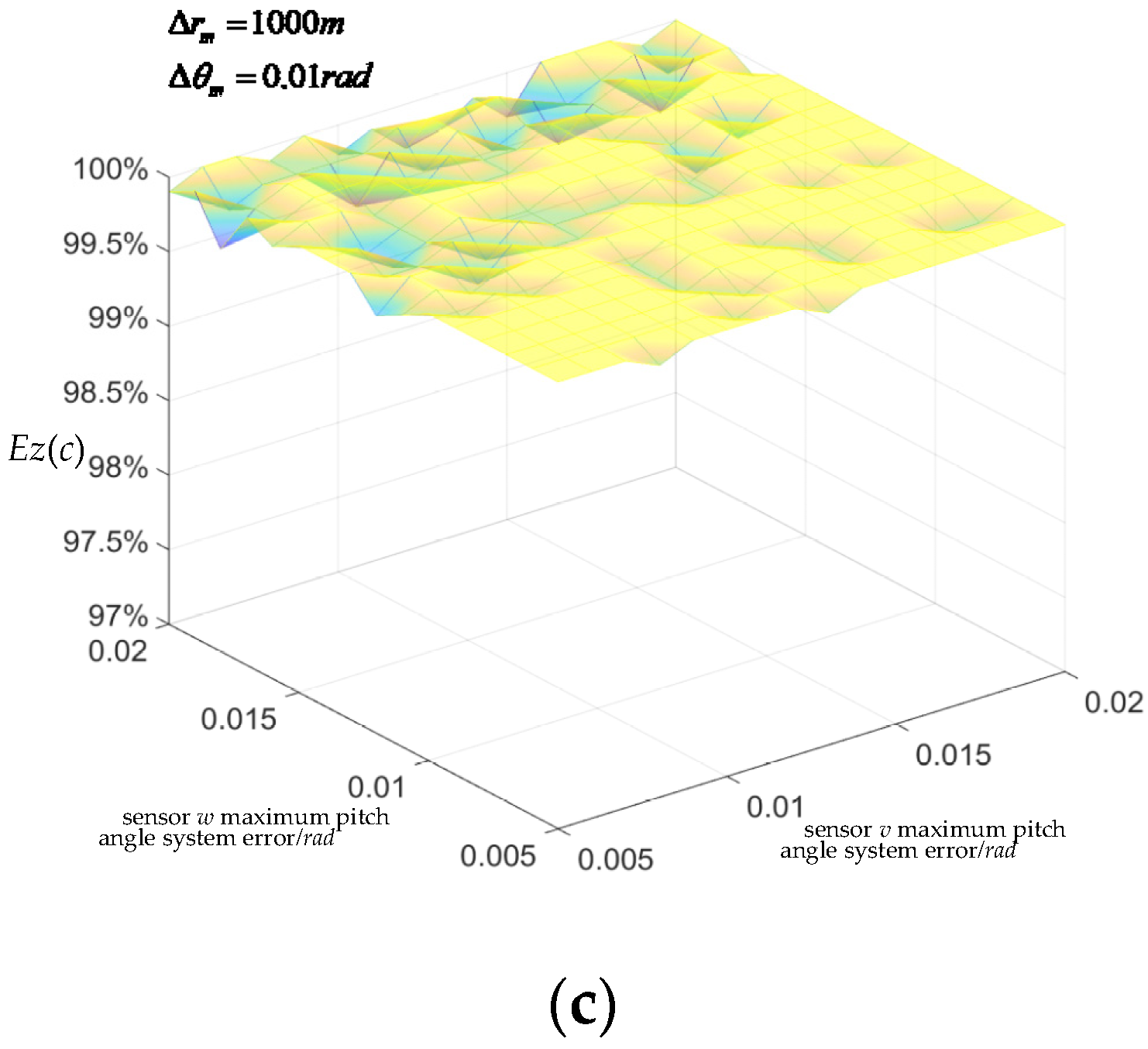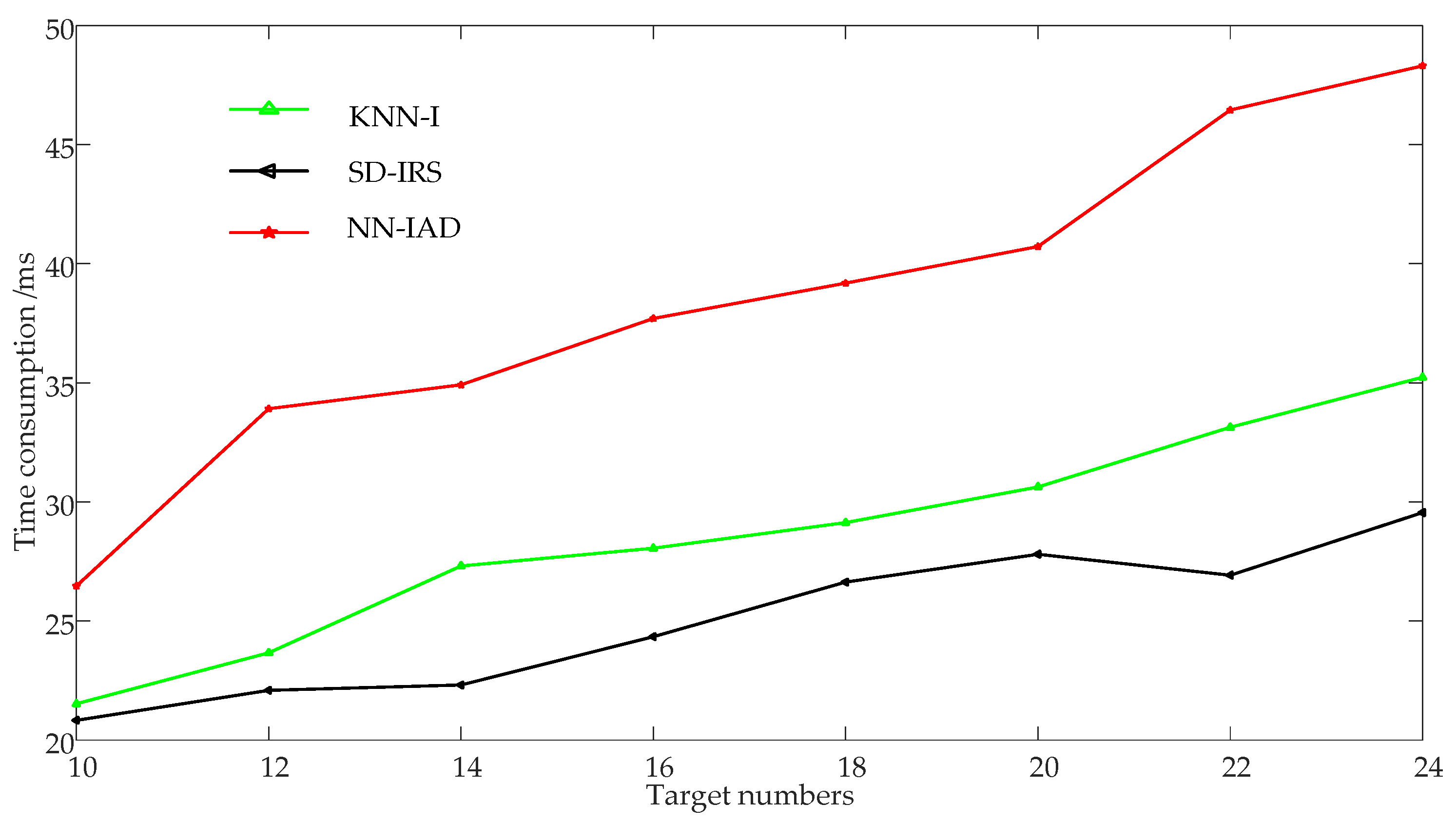Asynchronous Anti-Bias Track-to-Track Association Algorithm Based on Nearest Neighbor Interval Average Distance for Multi-Sensor Tracking Systems
Abstract
1. Introduction
- By processing the systematic errors interval of track coordinates and defining the nearest neighbor interval average distance between interval coordinate datasets and interval coordinate points, the correlation degree between the tracks is established, and an asynchronous anti-bias TTTA algorithm based on the nearest neighbor interval average distance is proposed. This algorithm does not require time domain alignment and error registration, effectively avoiding the introduction of new estimation errors and achieving TTTA under large systematic errors.
- The average correct association rate of the tracks of the algorithm under different cycle ratios, different delay startup times, and different noise distribution forms is analyzed, demonstrating its anti-interference and effectiveness.
- By analyzing the TTTA effect of the algorithm under different systematic errors and comparing the algorithms, the good anti-bias performance of the algorithm was verified.
- The average correct association rate, the number of false associations, and the maximum false association rate of various algorithms are compared under the simulation conditions of different target numbers and processing cycles, which proves that the proposed algorithm has strong robustness and superiority.
2. Materials and Methods
2.1. Mathematical Formula Definition
2.2. Mathematical Model Establishment
2.3. Asynchronous Anti-Bias TTTA Algorithm Based on the Nearest Neighbor Interval Average Distance
2.3.1. Data Reception
2.3.2. Systematic Errors Intervalization
2.3.3. Coordinate Transformation
2.3.4. Reference Datasets Selection
2.3.5. Derivation of Track Correlation Degree Matrix
2.3.6. Asynchronous TTTA Judgment
3. Experiments and Performance Analysis
3.1. Simulation Environment and Evaluation Index
3.2. Algorithm Performance Analysis
3.2.1. Algorithm Effectiveness Analysis
3.2.2. Systematic Errors Analysis
3.2.3. Comparison of Algorithm Performance
3.2.4. Algorithm Complexity Analysis
4. Conclusions
Author Contributions
Funding
Data Availability Statement
Conflicts of Interest
References
- Li, C.; Zhang, D.; Ge, J.; Wang, W. Target tracking with a dynamic and adaptive selection of radars based on entropy. J. Eng. 2019, 21, 7936–7939. [Google Scholar] [CrossRef]
- Ma, K.; Zhang, H.; Wang, R.; Zhang, Z. Target tracking system for multi-sensor data fusion. In Proceedings of the 2017 IEEE 2nd Information Technology, Networking, Electronic and Automation Control Conference (ITNEC), Chengdu, China, 15–17 December 2017. [Google Scholar]
- Durr, A.; Schweizer, B.; Bechter, J.; Waldschmidt, C. Phase noise mitigation for multistatic FMCW radar sensor networks using carrier transmission. IEEE Microw. Wirel. Compon. Lett. 2018, 28, 1143–1145. [Google Scholar] [CrossRef]
- Ren, P.; Munari, A.; Petrova, M. Performance tradeoffs of joint radar-communication networks. IEEE Wirel. Commun. Lett. 2018, 8, 165–168. [Google Scholar] [CrossRef]
- Chen, B.; Zhang, W.A.; Yu, L.; Hu, G.; Song, H. Distributed fusion estimation with communication bandwidth constraints. IEEE Trans. Autom. Control 2015, 60, 1398–1403. [Google Scholar] [CrossRef]
- Okello, N.N.; Challa, S. Joint sensor registration and track-to-track fusion for distributed trackers. IEEE Trans. Aerosp. Electron. Syst. 2004, 40, 808–823. [Google Scholar] [CrossRef]
- Xu, L.; Jin, S.L.; Yin, G.S. A track association algorithm based on leader-follower on-line clustering in dense target environment. Radioengineering 2014, 23, 259–265. [Google Scholar]
- Zhu, H.; Wang, W.; Wang, C. Robust track-to-track association in the presence of sensor biases and missed detections. Inf. Fusion 2016, 27, 33–40. [Google Scholar] [CrossRef]
- Wang, X.; Xu, Z.; Gou, X. Consensus-based track association with multistatic sensors under a nested probabilistic-numerical linguistic environment. Sensors 2019, 19, 1381. [Google Scholar] [CrossRef] [PubMed]
- Yu, Y.; Hou, Q.; Zhang, W.; Zhang, J. A sequential two-stage track-to-track association method in asynchronous bearings-only sensor networks for aerial targets surveillance. Sensors 2019, 19, 3185. [Google Scholar] [CrossRef] [PubMed]
- Lian, F.; Hou, L.; Wei, B.; Han, C. Sensor selection for decentralized large-scale multi-target tracking network. Sensors 2018, 18, 4115. [Google Scholar] [CrossRef]
- Yang, X.; Lian, J.; Ren, H. Research on shore-based intelligent vessel support system based on multi-source navigation sensors simulation. Int. J. Distrib. Sens. Netw. 2019, 15, 15501477198. [Google Scholar] [CrossRef]
- Wandelt, S.; Sun, X.; Fricke, H. ADS-BI: Compressed Indexing of ADS-B Data. IEEE Trans. Intell. Transp. Syst. 2018, 19, 3795–3806. [Google Scholar] [CrossRef]
- Li, P.; Fan, E.; Yuan, C. A Specific Iterative Closest Point Algorithm for Estimating Radar System Errors. IEEE Access 2020, 8, 6417–6428. [Google Scholar] [CrossRef]
- Hu, Q.; Su, H.; Zhou, S.; Liu, Z.; Liu, J. Target detection in distributed MIMO radar with registration errors. IEEE Trans. Aerosp. Electron. Syst. 2016, 52, 438–450. [Google Scholar] [CrossRef]
- Kanyuck, A.J.; Singer, R.A. Correlation of multiple-site track data. IEEE Trans. Aerosp. Electron. Syst. 1970, 6, 180–187. [Google Scholar] [CrossRef]
- Jian, G.; You, H.; Ying-Ning, P. Distributed CFAR detector based on local test statistic. Signal Process. 2000, 80, 373–379. [Google Scholar] [CrossRef]
- Liu, Y.; Yao, L.; Xiong, W.; Zhou, Z. GF-4 Satellite and automatic identification system data fusion for ship tracking. IEEE Geosci. Remote Sens. Lett. 2019, 16, 281–285. [Google Scholar] [CrossRef]
- Guo, J.; Han, C.; Li, L. Data fusion and bias registration based on sensor selection for large-scale sensor networks. In Proceedings of the 2017 29th Chinese Control and Decision Conference (CCDC), Chongqing, China, 28–30 May 2017. [Google Scholar]
- Wang, J.; Zeng, Y.; Wei, S.; Wei, Z.; Wu, Q.; Savaria, Y. Multi-Sensor Track-to-Track Association and Spatial Registration Algorithm Under Incomplete Measurements. IEEE Trans. Signal Process. 2021, 69, 3337–3350. [Google Scholar] [CrossRef]
- Zhu, H.; Leung, H.; Yuen, K.V. A joint data association, registration, and fusion approach for distributed tracking. Inf. Sci. 2015, 324, 186–196. [Google Scholar] [CrossRef]
- Bu, S.; Zhou, C.; Zhou, G. Simultaneous spatiotemporal bias and state estimation for asynchronous multi-sensor system. J. Eng. 2019, 19, 5824–5828. [Google Scholar] [CrossRef]
- Sun, W.; Li, X.; Pang, Z.; Ji, Y.; Dai, Y.; Huang, W. Track-to-Track Association Based on Maximum Likelihood Estimation for T/R-R Composite Compact HFSWR. IEEE Trans. Geosci. Remote Sens. 2023, 61, 1–12. [Google Scholar] [CrossRef]
- Qi, L.; Dong, K.; Liu, Y. Anti-bias track-to-track association algorithm based on distance detection. IET Radar Sonar Navigat. 2017, 11, 269–276. [Google Scholar] [CrossRef]
- Tian, W.; Wang, Y.; Shan, X.; Yang, J. Track-to-track association for biased data based on the reference topology feature. IEEE Signal Process. 2014, 21, 449–453. [Google Scholar] [CrossRef]
- Sönmez, H.H.; Hocaoğlu, A.K. Asynchronous track-to-track association algorithm based on reference topology feature. Signal Image Video Process. 2021, 16, 789–796. [Google Scholar] [CrossRef]
- Ahmed, I.; Jun, M.; Ding, Y. A Spatio-Temporal Track Association Algorithm Based on Marine Vessel Automatic Identification System Data. IEEE Trans. Intell. Transp. Syst. 2022, 23, 20783–20797. [Google Scholar] [CrossRef]
- Cao, Y.; Cao, J.; Zhou, Z. Track Segment Association Method Based on Bidirectional Track Prediction and Fuzzy Analysis. Aerospace 2022, 9, 274. [Google Scholar] [CrossRef]
- Sujit, K.D. On Degree of Fuzziness and Fuzzy Decision Making. Cybern. Syst. 2020, 51, 600–614. [Google Scholar]
- Yao, Y.; Wang, S. Effects of Atmospheric Correction and Image Enhancement on Effective Plastic Greenhouse Segments Based on a Semi-Automatic Extraction Method. ISPRS Int. J. Geo-Inf. 2022, 11, 585. [Google Scholar] [CrossRef]
- Yi, X.; Zhang, H.W. A track association algorithm for distributed multi-target systems based on gray interval numbers. Acta Aeronaut. Astronaut. Sin. 2013, 34, 352–360. [Google Scholar]
- Crnogorac, L.; Lutovac, S.; Tokalić, R.; Gligorić, M.; Gligorić, Z. Steel Arch Support Deformations Forecast Model Based on Grey–Stochastic Simulation and Autoregressive Process. Appl. Sci. 2023, 13, 4559. [Google Scholar] [CrossRef]
- Yi, X.; Han, J.Y. Asynchronous track-to-track association algorithm based on similarity degree of interval-real sequence. Acta Aeronaut. Astronaut. Sin. 2015, 36, 1212–1220. [Google Scholar]
- Yi, X.; Du, J.P. Asynchronous track-to-track association algorithm based on discrete degree of segmented sequence. Acta Aeronaut. Astronaut. Sin. 2020, 41, 265–274. [Google Scholar]
- Xin, G.; You, H.; Xiao, Y. Gray track-to-track correlation algorithm for distributed multitarget tracking system. Signal Process. 2006, 86, 3448–3455. [Google Scholar] [CrossRef]
- Ristic, B.; Okello, N. Sensor registration in ECEF coordinates using the MLR algorithm. In Proceedings of the 2003 Sixth International Conference of Information Fusion, Cairns, Australia, 8–11 July 2003. [Google Scholar]
- Yi, X.; Zeng, R.; Cao, X.Y. Asynchronous anti-bias track association algorithm by using k-nearest neighbors interval distance. Syst. Eng. Electron. 2022, 44, 1475–1482. [Google Scholar]








| Parameter Settings | Sampling Cycle | Geographical Coordinates | Oblique Distance Random Error | Azimuth Angle Random Error | Pitch Angle Random Error |
|---|---|---|---|---|---|
| v | 6 s | (0°, 0°, 0 m) | 50 m | 0.001 rad | 0.001 rad |
| w | 4 s | (0°, 0.2°, 0 m) | 50 m | 0.001 rad | 0.001 rad |
| The Processing Cycle of the FC | The Number of Targets | Maximum Oblique Distance Random Error | Maximum Azimuth Angle Random Error | Maximum Pitch Angle Random Error |
|---|---|---|---|---|
| 50 s | 20 | 1000 m | 0.01 rad | 0.02 rad |
| Sampling Period Ratio | k = 1 | k = 1.5 | k = 2 | k = 2.5 | k = 3 |
|---|---|---|---|---|---|
| time consumed | 0.07023 | 0.05654 | 0.05030 | 0.04888 | 0.04235 |
| Startup Time Difference (s) | The Evaluation Indexes | Sampling Cycle Ratio | ||||
|---|---|---|---|---|---|---|
| k = 1 | k = 1.5 | k = 2 | k = 2.5 | k = 3 | ||
| 1 | 1 | 0 | 1 | 0 | 2 | |
| 99.9% | 100% | 99.9% | 100% | 99.8% | ||
| 1.5 | 2 | 2 | 1 | 0 | 2 | |
| 99.8% | 99.8% | 99.9% | 100% | 99.8% | ||
| 2 | 0 | 0 | 0 | 3 | 3 | |
| 100% | 100% | 100% | 99.7% | 99.7% | ||
| 2.5 | 3 | 1 | 2 | 1 | 3 | |
| 99.7% | 99.9% | 99.8% | 99.9% | 99.7% | ||
| Different Noise Distribution Forms | Gaussian Distribution | Rayleigh Distribution | Exponential Distribution | Uniform Distribution |
|---|---|---|---|---|
| 99.8% | 99.7% | 99.8% | 100% |
| The Processing Cycle of the FC | The Number of Targets | Maximum Oblique Distance Random Error | Maximum Azimuth Angle Random Error | Maximum Pitch Angle Random Error |
|---|---|---|---|---|
| 30 s | 20 | 500 m~2000 m | 0.005 rad~0.02 rad | 0.005 rad~0.02 rad |
| The Processing Cycle of the FC | The Number of Targets | Maximum Oblique Distance Random Error | Maximum Azimuth Angle Random Error | Maximum Pitch Angle Random Error |
|---|---|---|---|---|
| 30 s | 20 | 100~1500 m | 0.005~0.015 rad | 0.005~0.015 rad |
| Maximum Systematic Errors | NN-IAD | SD-IRS | ||||||
|---|---|---|---|---|---|---|---|---|
| 100 | 0.01 | 0.01 | 100.0% | 0 | 0 | 90.6% | 91 | 30% |
| 500 | 0.01 | 0.01 | 99.9% | 1 | 10% | 75.4% | 100 | 45% |
| 1000 | 0.01 | 0.01 | 99.8% | 2 | 10% | 57.8% | 100 | 50% |
| 1500 | 0.01 | 0.01 | 99.9% | 1 | 10% | 53.4% | 100 | 55% |
| 1000 | 0.005 | 0.01 | 100.0% | 0 | 0 | 53.6% | 100 | 55% |
| 1000 | 0.015 | 0.01 | 99.9% | 1 | 10% | 63.6% | 100 | 50% |
| 1500 | 0.01 | 0.005 | 99.9% | 1 | 10% | 55.6% | 100 | 50% |
| 1500 | 0.01 | 0.015 | 100.0% | 0 | 0 | 55.5% | 100 | 55% |
| 500 | 0.005 | 0.005 | 99.9% | 1 | 10% | 74.1% | 100 | 45% |
| 500 | 0.015 | 0.015 | 99.6% | 4 | 10% | 75.9% | 100 | 45% |
| 1000 | 0.005 | 0.005 | 100.0% | 0 | 0 | 63.7% | 100 | 55% |
| 1000 | 0.015 | 0.015 | 100.0% | 0 | 0 | 56.6% | 100 | 55% |
| 1500 | 0.005 | 0.005 | 99.9% | 1 | 10% | 53.5% | 100 | 55% |
| 1500 | 0.015 | 0.015 | 99.8% | 2 | 10% | 59.4% | 100 | 55% |
| The Processing Cycle of the FC | The Number of Targets | Maximum Oblique Distance Random Error | Maximum Azimuth Angle Random Error | Maximum Pitch Angle Random Error |
|---|---|---|---|---|
| 20:2:50 s | 10:1:50 | 1000 m | 0.01 rad | 0.02 rad |
| The Processing Cycle of the FC | The Number of Targets | Maximum Oblique Distance Random Error | Maximum Azimuth Angle Random Error | Maximum Pitch Angle Random Error |
|---|---|---|---|---|
| 30 s | 10:2:24 | 1000 m | 0.01 rad | 0.02 rad |
Disclaimer/Publisher’s Note: The statements, opinions and data contained in all publications are solely those of the individual author(s) and contributor(s) and not of MDPI and/or the editor(s). MDPI and/or the editor(s) disclaim responsibility for any injury to people or property resulting from any ideas, methods, instructions or products referred to in the content. |
© 2023 by the authors. Licensee MDPI, Basel, Switzerland. This article is an open access article distributed under the terms and conditions of the Creative Commons Attribution (CC BY) license (https://creativecommons.org/licenses/by/4.0/).
Share and Cite
Chen, S.; Ma, J.; Zhang, H.; Wang, Y. Asynchronous Anti-Bias Track-to-Track Association Algorithm Based on Nearest Neighbor Interval Average Distance for Multi-Sensor Tracking Systems. Electronics 2023, 12, 2413. https://doi.org/10.3390/electronics12112413
Chen S, Ma J, Zhang H, Wang Y. Asynchronous Anti-Bias Track-to-Track Association Algorithm Based on Nearest Neighbor Interval Average Distance for Multi-Sensor Tracking Systems. Electronics. 2023; 12(11):2413. https://doi.org/10.3390/electronics12112413
Chicago/Turabian StyleChen, Shuangyou, Juntao Ma, Hongwei Zhang, and Yinlong Wang. 2023. "Asynchronous Anti-Bias Track-to-Track Association Algorithm Based on Nearest Neighbor Interval Average Distance for Multi-Sensor Tracking Systems" Electronics 12, no. 11: 2413. https://doi.org/10.3390/electronics12112413
APA StyleChen, S., Ma, J., Zhang, H., & Wang, Y. (2023). Asynchronous Anti-Bias Track-to-Track Association Algorithm Based on Nearest Neighbor Interval Average Distance for Multi-Sensor Tracking Systems. Electronics, 12(11), 2413. https://doi.org/10.3390/electronics12112413





